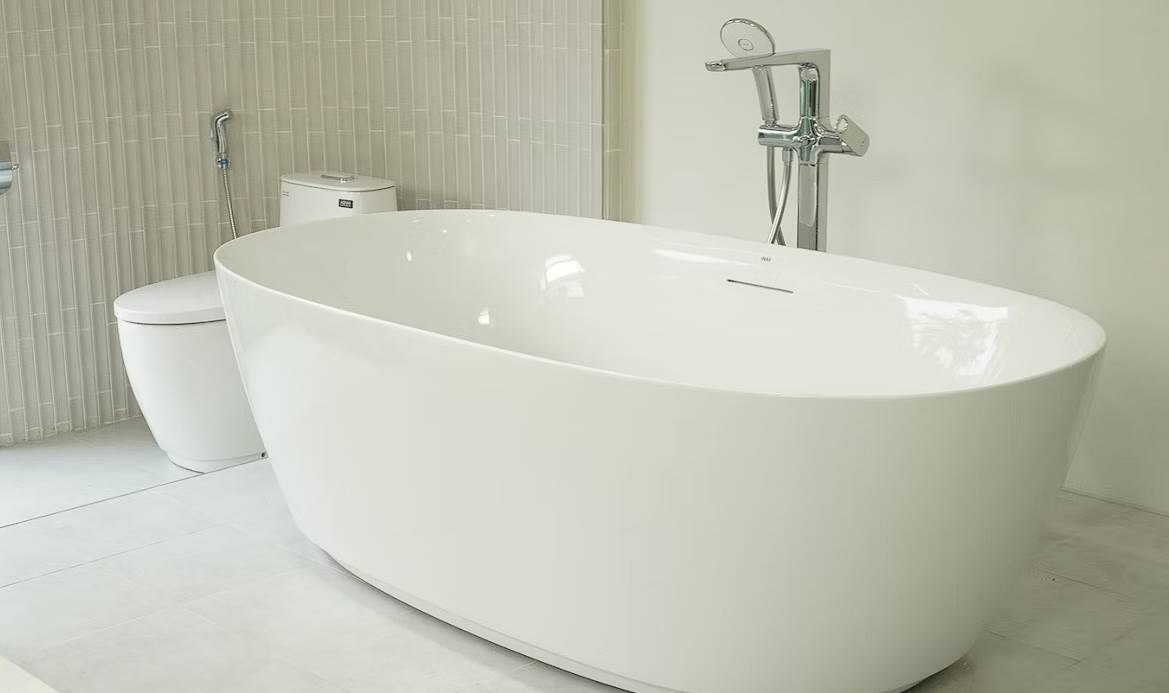If your bathtub shows signs of wear and you're considering refinishing, it can initially feel overwhelming. However, with the right approach, you can successfully remove paint from your bathtub without causing any damage to the underlying surface. Follow these step-by-step instructions to achieve the desired results.
Before you begin, it's essential to protect the surrounding area. Cover the walls, floor, and nearby items with plastic tarps to prevent paint splatters or drips from causing additional mess or damage.
But what should you do if paint accidentally lands on your new bathtub? The method to remove the paint will depend on the bathtub's material. Commercial paint strippers can be harsh and harm surfaces like fibreglass and acrylic. Before using strong chemicals and solvents, consider trying one of the natural methods outlined below. The best part is that you likely have the necessary supplies at home.
How to Get Paint Off of Different Kinds of Bathtubs
Redecorating a home is often exciting, especially when choosing new wall colours. However, when repainting a bathroom, it's almost unavoidable to encounter some mess, and paint may unintentionally end up on various surfaces, including floor tiles and the bathtub.
Removing paint from these surfaces can be challenging, so it's highly recommended to take preventive measures by covering the areas you want to keep clean. However, if paint does end up in your bathtub, there's no need to panic, as there are effective methods available for paint removal, depending on the material of the bathtub.
Acrylic Bathtubs
When it comes to removing paint from acrylic bathtubs, it's crucial to avoid abrasive cleaners and paint-remover solutions as they can cause irreparable damage. Instead, opt for a nonabrasive cleaner containing bleach, which is safe for acrylic surfaces and can effectively remove paint spots. Start by using paper towels to absorb as much of the fresh paint as possible. Then, treat the remaining paint with a liquid laundry detergent or a vinegar-based bathtub cleaner.
To tackle paint stains on the sides of the tub, fill the bathtub with hot water, ensuring the stains are fully covered, and add three ounces of laundry soap per two inches of water. Allow the solution to soak overnight, which will help loosen the paint. Scrub the paint stains firmly using a soft sponge. You can either drain the tub or leave the solution on the stain while washing. For stubborn spots, keep the area wet with hot water to prevent the paint from drying and hardening. Apply a generous amount of baking soda to the spot and let it sit for 10 minutes. Then, spray vinegar onto the spot. The resulting foam from the reaction between baking soda and vinegar will break down the remaining paint. In case some spots persist, directly apply vinegar to the sponge and scrub while the bubbling occurs.
Porcelain Tub Surfaces
Removing paint spills from porcelain tubs requires different methods compared to acrylic tubs. Porcelain is more durable, allowing for a wider range of removal options. For water-based paint, vigorously rub the stain with rubbing alcohol, a cotton pad, or a clean rag. If the paint starts to come off, continue until it is completely removed. For tougher stains, you can use stronger chemicals like acetone, but make sure to ventilate the bathroom properly to avoid inhaling fumes.
When dealing with oil-based paint spills, start by wiping off the excess paint. Ventilate the room and apply a small amount of paint stripper to the affected area using a paintbrush. Leave the room and let the stripping agent work for approximately 10 minutes. If the paint begins to bubble and crack, remove the stripping agent and assess if a second treatment is necessary. If you prefer to avoid chemicals on your bathtub surface, let the paint dry and scrape it off using a plastic putty knife. Porcelain is resistant to scratching, so with some effort, you can gently work at the spot and remove the paint without harsh chemical removers.
Fiberglass Bathtubs
Removing fresh paint from fiberglass tubs is relatively simple. Start by running warm or hot water over the affected area to loosen the paint. In many cases, the paint should come off easily with water alone. However, if the paint has already dried, scraping may be required.
To scrape off dried paint, use a plastic paint scraper instead of a metal one to prevent accidental scratches on the fiberglass surface. Gently scrape away the paint, being careful not to apply excessive pressure. After scraping, rinse the stained area with soapy water to remove any remaining residue. For minor stains, create a paste using baking soda and water, apply it to the stained spots, and scrub gently with a damp sponge. Rinse the area thoroughly and repeat the process if necessary until the fiberglass tub is spotless.
Metal Bathtubs
Metal bathtubs, such as copper and stainless steel, require careful maintenance to prevent damage. To remove paint stains from these surfaces, begin by thoroughly cleaning the bathtub to remove any dirt or debris. Once the surface is clean, apply olive oil to the paint stain using paper towels and let it sit for a few minutes to loosen the paint.
Wrap a plastic paint scraper with a thin rag to remove the paint without scratching the metal. Use this wrapped scraper to gently scrape the lubricated surface and remove as much paint as possible. Next, dampen a clean rag with mineral spirits and apply it to the remaining paint stain, allowing it to sit on the surface for one minute. Use a different clean rag to wipe away the loosened paint. This method can also be used to remove paint from faucet fixtures and caulk.
It's important to remember that the appropriate removal methods may vary depending on the type of paint and surface you are dealing with. Adjust the cleaning technique accordingly if you encounter epoxy paint peeling from a fiberglass bathtub or latex paint drips on a porcelain tub. By following these steps and using gentle cleaning methods, you can effectively remove paint stains from metal bathtubs without causing any damage to the surface.
Will Paint Thinner Hurt A Bathtub?
Using non-abrasive cleansers specifically designed for acrylic surfaces is essential to clean and removing paint from an acrylic bathtub effectively. Harsh cleaning chemicals and abrasive materials can cause scratches and damage the protective coating of the acrylic.
Avoid using ordinary cleaning chemicals like Comet and Ajax, as they are too harsh for acrylic tubs. Look for non-acetate cleansers, as acetates can harm the gel coat on the acrylic surface. Similarly, avoid using paint thinners as they can have an abrasive impact similar to scrub pads or steel wool.
Mild all-purpose cleansers such as OxyClean, Bathtub & Shower Cleaner, and Kaboom are effective in cleaning acrylic bathtubs without causing damage to the clear coat finish.
It's important to note that acrylic and other plastic-based materials are less durable than porcelain, so extra care must be taken to avoid harsh chemicals and solvents that can damage the tub's protective covering.
While a paint stripper may be suitable for removing paint from a stained surface in a porcelain tub, it is not recommended for acrylic or fibreglass tubs.
The above cleaning methods are safe and suitable for removing paint from a fibreglass bathtub. Still, it's essential to use caution and select products specifically formulated for acrylic tubs to avoid damage.
Conclusion
Cover the walls, the floor, and any close objects with plastic tarps for safety. Depending on the bathtub's material, there are efficient methods for painting over a paint stain. Avoid using harsh chemicals, such as abrasive cleaners or paint-remover solutions, on your acrylic bathtub. Use paper towels and a nonabrasive cleanser like bleach to remove as much paint as possible.
Important information in this book includes instructions for cleaning paint spots from the interior of a bathtub. Use rubbing alcohol or harsher chemicals and massage the stain hard to remove water-based paint. Wipe off the extra oil-based paint and then apply a paint remover. To remove paint off a fibreglass bathtub, fill the tub with warm or hot water and run it over the spot. It might be required to scrape off the paint if it has dried.
To remove dried paint from a fibreglass tub, use a plastic paint scraper. Use soapy water to rinse the area, then make a paste of baking soda and water to clean the area thoroughly. Metal bathtubs need special care to prevent rusting and corrosion. Olive oil and a plastic paint scraper wrapped in a thin rag will remove paint stains from metal bathtubs. Remove any residual paint with mineral spirits and a clean rag.
If necessary, readjust your cleaning strategy. To clean and strip paint from an acrylic tub, you'll need both abrasive and non-abrasive cleaners. Acrylic and fibreglass bathtubs are not suitable for use with paint remover.
Content Summary
- Learn how to remove paint from a bathtub without causing damage.
- Protect the surrounding area before starting the paint removal process.
- Different methods are required depending on the material of the bathtub.
- Commercial paint strippers can harm surfaces like fibreglass and acrylic.
- Use nonabrasive cleaners containing bleach for acrylic bathtubs.
- Absorb fresh paint with paper towels before treating the remaining spots.
- Soak the bathtub in a solution of hot water and laundry soap for stubborn stains.
- Scrub paint stains firmly with a soft sponge.
- Baking soda and vinegar can be used to break down remaining paint spots on acrylic tubs.
- Rubbing alcohol or acetone can be used to remove water-based or oil-based paint from porcelain tubs.
- Ventilate the bathroom properly when using stronger chemicals for paint removal on porcelain tubs.
- Use a plastic paint scraper to remove fresh paint from fibreglass tubs.
- Warm or hot water can help loosen paint on fiberglass tubs.
- Create a paste with baking soda and water to remove minor paint stains on fibreglass tubs.
- Metal bathtubs require careful maintenance to prevent damage.
- Thoroughly clean the bathtub before removing paint stains.
- Apply olive oil to the paint stain to loosen it.
- Use a plastic paint scraper wrapped with a rag to gently scrape the paint from metal bathtubs.
- Mineral spirits can be used to remove remaining paint stains from metal bathtubs.
- Avoid using harsh chemicals and abrasive materials on acrylic tubs to prevent damage.
- Non-acetate cleansers are recommended for acrylic tubs.
- Ordinary cleaning chemicals like Comet and Ajax can be too harsh for acrylic tubs.
- Mild all-purpose cleansers like OxyClean are effective for cleaning acrylic bathtubs.
- Acrylic and plastic-based materials are less durable than porcelain, requiring extra care.
- Paint strippers are not recommended for acrylic or fiberglass tubs.
- Take caution and select products specifically formulated for acrylic tubs.
- Avoid using paint thinners on acrylic tubs as they can be abrasive.
- Care must be taken to avoid damage to the tub's protective coating.
- Use gentle cleaning methods to remove paint stains from metal bathtubs.
- Select products that are safe and suitable for acrylic and fibreglass tubs to avoid damage.
Frequently Asked Questions
Dish soap and a safety razor blade can remove even old, dried-on paint. Mix dish soap with warm water until frothy, and thoroughly wet the window with a sponge or rag. Hold the razor blade at a 45-degree angle and carefully scrape the paint away, keeping the glass damp to avoid scratches.
Don't use solvents (turpentine, lacquer thinner, mineral spirits, paint thinner, MEK, xylene, acetone, naphtha, etc.) that can wreak havoc on an acrylic surface. You can prevent damage to your acrylic shower or tub with some care and consideration.
Yes, bathtubs can be painted with a near-new finish with some elbow grease. You need the right equipment and tools, such as an epoxy primer and resin finish.
Using either an orbital sander or hand sanding, the damaged edges are feathered with 180-grit sandpaper and sprayed with water to control the dust. In some cases, when the topcoat does not feather well, adhesion of the finish is considered poor, and the entire bathtub is sanded with 40 to 80-grit sandpaper.
A reglazed tub is usually ready to use 48 to 72 hours after the process. On the other hand, some refinishing companies use materials that dry fast and will be ready for use after 24 hours. Additionally, some can provide a 4-hour cure product so you can use your tub within the same day.



